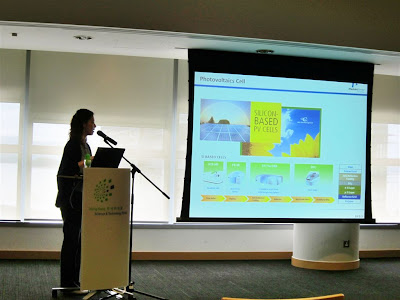The speaker was Ms. Michelle Lee (Specialist, PerkinElmer (Hong Kong) Limited). The content was summarized below.

In the beginning, Ms. Lee introduced different analytical technique employed in each stage of silicon-based PV cells process.
The following slides showed the properties of the incident light through a material.


The speaker introduced UV/VIS/NIR spectrometer which can help to measure these properties. The PerkinElmer Lambda series spectrophotometer with 150mm integrating sphere was used in PV Test Laboratory in HKSTP.
Ms. Lee explained why we needed to use integrating sphere because of sampling errors during material measurement.

There were four types of measurements: Transmission (T), Diffuse Reflectance, Total Reflectance (R), Absorptance (A) and Haze.



Absorptance is the percentage of energy incident on a specimen that is not directly transmitted or reflected
The expression is described as: T + R + A = 1 or
%Absorptance = 100% - Direct Transmission - %Reflected
The Haze Measurement was based on ASTM 1003-92 and shown as follow.


Then, Ms. Lee briefed the application of solar measurements on Architectural Glass, which can control the transmission of visible light, total solar energy and longer wave thermal radiation within wide limits to reduce energy consumption for the regulation of temperature in a building. Reflectance and transmission are important parameters of architectural glass.
Finally, PV Cell Properties Measurement was discussed.
Triple junction solar cell design was shown. Multiple layers of thin films can produce very complex interference patterns.

For more information:
ASTM E 903-96: Standard Test Method for Solar Absorptance, Relflectance, and Transmittance of Materials using Integrating Spheres.
ASTM E 424-71: Standard Test Method for Transmittance and Reflectance (Terrestrial) of Sheet Materials.
ASTM E 490-73: Standard Solar Constant and Air Mass Zero Solar Spectral Irradiance Tables
ASTM E 891-87: Standard Tables for Terrestrial Direct Normal Solar Spectral Irradiance for Air Mass 1.5
ISO 9050 / EN 410: Glass in building – Determination of light transmittance, solar direct transmittance, total solar energy, transmittance and ultraviolet transmittance, and related glazing factors.
PV Optics software: http://www.nrel.gov/pv/measurements/computational_modeling.html
PerkinElmer Application Note for UV/Vis/NIR Spectrometer:
Dharma J. & Pisal A. (2009) “Simple Method of Measuring the Band Gap Energy Value of TiO2 in the Powder Form using a UV/Vis/NIR Spectrometer”

There were four types of measurements: Transmission (T), Diffuse Reflectance, Total Reflectance (R), Absorptance (A) and Haze.



Absorptance is the percentage of energy incident on a specimen that is not directly transmitted or reflected
The expression is described as: T + R + A = 1 or
%Absorptance = 100% - Direct Transmission - %Reflected
The Haze Measurement was based on ASTM 1003-92 and shown as follow.


Then, Ms. Lee briefed the application of solar measurements on Architectural Glass, which can control the transmission of visible light, total solar energy and longer wave thermal radiation within wide limits to reduce energy consumption for the regulation of temperature in a building. Reflectance and transmission are important parameters of architectural glass.
Finally, PV Cell Properties Measurement was discussed.
Triple junction solar cell design was shown. Multiple layers of thin films can produce very complex interference patterns.

For more information:
ASTM E 903-96: Standard Test Method for Solar Absorptance, Relflectance, and Transmittance of Materials using Integrating Spheres.
ASTM E 424-71: Standard Test Method for Transmittance and Reflectance (Terrestrial) of Sheet Materials.
ASTM E 490-73: Standard Solar Constant and Air Mass Zero Solar Spectral Irradiance Tables
ASTM E 891-87: Standard Tables for Terrestrial Direct Normal Solar Spectral Irradiance for Air Mass 1.5
ISO 9050 / EN 410: Glass in building – Determination of light transmittance, solar direct transmittance, total solar energy, transmittance and ultraviolet transmittance, and related glazing factors.
PV Optics software: http://www.nrel.gov/pv/measurements/computational_modeling.html
PerkinElmer Application Note for UV/Vis/NIR Spectrometer:
Dharma J. & Pisal A. (2009) “Simple Method of Measuring the Band Gap Energy Value of TiO2 in the Powder Form using a UV/Vis/NIR Spectrometer”
沒有留言:
發佈留言